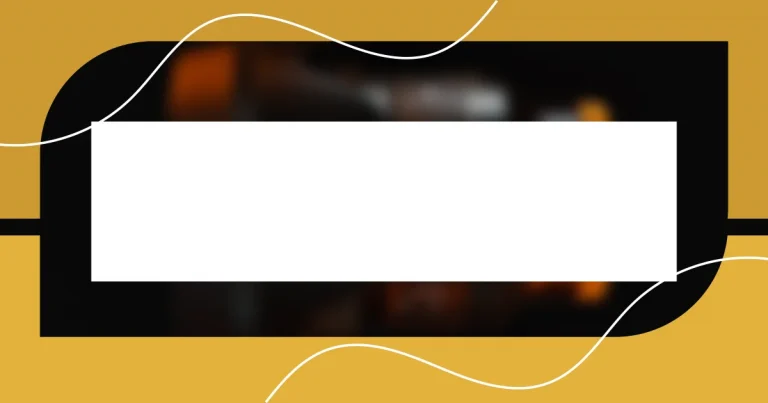Key takeaways:
- Effective preparation, including location scouting and creating shot lists, significantly enhances the success of product shoots.
- Adapting to unforeseen circumstances, such as equipment malfunctions or last-minute client changes, can lead to creative opportunities and innovative solutions.
- Open communication with team members and clients fosters collaboration, transforming challenges into achievements and improving final results.

Identifying Common Product Shoot Challenges
When I think about product shoots, a few challenges immediately come to mind. Lighting is often the first hurdle; inadequate lighting can distort colors and textures in ways that are frustrating. Have you ever taken a photo and realized it doesn’t reflect the product’s true essence? It’s disheartening, isn’t it?
Another common challenge is the arrangement of products. I recall a time when I worked with a particularly tricky-shaped item that refused to stay still. After numerous attempts, I learned that proper support and placement can make all the difference. It’s fascinating how the smallest adjustments can significantly impact the overall composition, reminding me that patience is key.
Then there’s the model interaction, particularly when dealing with people. I remember working with a shy model who struggled to express the confidence we needed for the shoot. It struck me how vital it is to create an environment where everyone feels comfortable. How do we tap into genuine emotions that convey the right message? Engaging with our team and product authentically is crucial to overcoming these challenges.

Preparing for a Successful Shoot
Preparation is essential for a successful product shoot. I always take time to create a detailed plan or shot list before the day arrives. It’s a bit like mapping out a journey; having a clear direction helps streamline the entire process and reduces unexpected surprises. I once arrived on set without a specific plan, and I found myself scrambling to figure out what to do next. That experience taught me the value of preparation—setting a clear agenda makes everything easier.
Here are a few quick tips for effective shoot preparation:
- Scout the Location: Understanding how the space interacts with lighting helps you decide on setups in advance.
- Gather Equipment: I always double-check my gear, ensuring I have all necessary props and tools ready to go.
- Perform Lighting Tests: Experimenting with different light settings before the shoot saves time and stress.
- Communicate with the Team: Briefing everyone involved creates alignment and sets expectations, easing potential anxieties.
- Create a Mood Board: Visual references can help maintain a shared vision among the team.
A well-prepared shoot not only enhances productivity but also fosters creativity. When I feel ready, it’s easier to explore new ideas without hesitation.

Technical Setup for Product Photography
The technical setup for product photography is crucial, and I treat it as the backbone of the shoot. Lighting is one of the most significant factors; I often use a combination of natural light and softbox lights. This blend helps create an even, flattering illumination that showcases details beautifully. One time, I tried shooting a shiny product using harsh lighting, which resulted in frustrating glare. I learned that it’s not just about having lights but knowing how to manipulate them.
In my experience, camera settings are equally important. I usually shoot in manual mode to maintain control over the aperture, shutter speed, and ISO. For instance, I remember a shoot where I had the ISO too high, which led to grainy images. Keeping my ISO low in well-lit conditions can produce sharp, clear photos. It’s an adjustment that can make a significant difference in the final result.
Tripods play a surprising yet vital role in my setup as well. They keep my camera steady, ensuring the sharpest focus, particularly during longer exposures. I can’t tell you how many times my hands have betrayed me, leading to blurry photos. So, I’ve made it a habit to use a tripod, as it allows for precise positioning and greater creativity in framing. Each aspect of the technical setup, from lighting to camera settings and stabilization, interconnects to create stunning product visuals.
| Element | Considerations |
|---|---|
| Lighting | Use a mix of natural and artificial light for balanced illumination. |
| Camera Settings | Shooting in manual mode provides control over image quality and prevents unwanted grain. |
| Tripod | A steady camera helps maintain clarity, especially in low-light situations or with longer exposures. |

Creative Solutions to Common Problems
When faced with unexpected distractions on set, I’ve learned to think outside the box. For instance, once during a shoot, a noisy construction crew nearby threatened to derail our focus. Instead of allowing frustration to take over, I suggested an impromptu prop game to keep the team engaged and light-hearted while we waited. That moment not only turned a potential setback into a bonding experience but also sparked some creative angles and ideas I hadn’t considered.
Sometimes, the challenge is not physical but conceptual. I remember a product launch where the color palette didn’t match our envisioned theme. Instead of getting bogged down, we leveraged it by creating an entirely new visual story around those colors. By shifting our perspective and embracing the unexpected, we crafted an engaging narrative that added to the brand’s charm. Isn’t it interesting how limitations can lead to some of the most creative outcomes?
Then there are times when the timeline gets crunched, affecting workflow. I recall a shoot where we had a tight deadline for a product release. The pressure was palpable, but instead of succumbing to stress, I introduced a rapid-fire brainstorming session. Each team member shared quick ideas for the shoot, sparking an energy that turned the situation around. Those high-pressure moments can be intimidating, but I find they often push us to discover innovative solutions we might not have explored otherwise. Wouldn’t you agree that creativity often flourishes under a little pressure?

Adapting to Unforeseen Circumstances
Adapting to unforeseen circumstances is an essential skill in product shoots. I remember one particular day when the weather turned unexpectedly during an outdoor session. The bright, sunny forecast quickly shifted to dark clouds, and I panicked at first. Instead of giving in to frustration, I quickly gathered my team to brainstorm alternative setups. We decided to incorporate the moody atmosphere into our shots, which added a dramatic flair that ended up enhancing the product’s appeal. It’s funny how a potential obstacle can morph into an opportunity if we’re willing to adjust our mindset.
Technical hiccups can also throw a wrench in our plans. Once, I experienced a sudden equipment malfunction right before a crucial shoot. My initial reaction was one of panic—what would I do without my favorite lens? After a brief moment of despair, I remembered my backup gear, which I usually packed just in case. It wasn’t ideal, but I adapted my shot compositions to work with the new lens, and surprisingly, it led to some unique perspectives that added an unexpected character to the photographs.
Another challenge that often arises is dealing with last-minute changes from clients. I recall a situation when a client requested a complete overhaul of the shoot concept just hours before we began. Initially, this made me anxious; after all, we had planned meticulously. But rather than resist the change, I focused on the possibilities instead. I encouraged a collaborative approach, bouncing ideas off my team and quickly sketching out a new vision. Embracing that uncertainty not only ignited my creativity but also reinforced my belief that adaptability is key in this fast-paced field. How have you learned to embrace change in your creative processes?

Post-Shoot Processes and Considerations
After the shooting wraps up, I find myself diving into the post-shoot processes that can truly make or break the final output. For instance, there’s the crucial step of sorting through and reviewing the images we’ve captured. I can’t stress enough how important it is to do this while the experience is still fresh in your mind. It’s like revisiting a great movie right after the credits roll; my emotions are still raw, and I can identify which moments sparked joy or intrigue. I remember a shoot where I overlooked a few golden shots during initial reviews, but later, I noticed their potential when I switched my perspective. That felt like opening a treasure chest!
Processing isn’t just about the technical side; it’s also about storytelling. I often find myself reflecting on the narrative we aimed to create. Did we achieve our vision, or are there gaps? During one project, I realized the product’s benefits weren’t shining through as we’d hoped, so I chose to spotlight those features in post-production. By enhancing specific aspects through edits—like color adjustments or cropping—I infused new life into the images, showcasing not just a product but an experience. Have you ever had that eye-opening moment where a simple tweak completely changes the narrative?
Lastly, communication with the client during this phase is vital. I recommend setting aside time to discuss the final selections and edits. During one specific project, I was nervous about client feedback after the shoot. When I proactively shared my vision for the edits, it opened a dialogue that enriched the final product. Isn’t it fascinating how collaboration can transform our individual insights into something even greater? I’ve learned that working closely with the client beyond the shoot creates a shared ownership of the final images, allowing us to celebrate the journey together.

Lessons Learned for Future Shoots
Reflecting on past product shoots, I’ve learned that preparation is only the beginning—flexibility is crucial. I once had an entire shoot planned around a specific backdrop, only to find out it was suddenly unavailable. Instead of dwelling on the loss, I took a breath and started looking around. I discovered an intriguing alleyway nearby that offered a completely different vibe. That spontaneous change not only salvaged the day but created some of my favorite shots. Isn’t it fascinating how limitations can spark creativity?
One of the biggest lessons I’ve taken to heart is the power of effective communication with my team. In a recent project, we faced a mix-up related to a client’s specifications. Instead of letting it derail us, I called for an impromptu team meeting. We calmly discussed what went wrong, brainstormed solutions, and, in the end, produced images that exceeded the client’s expectations. This experience drove home the point that open dialogue can transform potential disasters into achievements. How often do we forget that clear communication is a tool for collective success?
Lastly, I can’t emphasize enough the significance of embracing feedback, both from clients and peers. I vividly recall a situation where I was hesitant to share my initial edits, worrying the client might not resonate with my artistic vision. When I finally did, their feedback illuminated a different perspective I had overlooked. It turned out their insights helped refine our concept even further. This taught me that feedback isn’t criticism; it’s an opportunity for growth and collaboration. Isn’t it amazing how diverse viewpoints can enhance our work?














